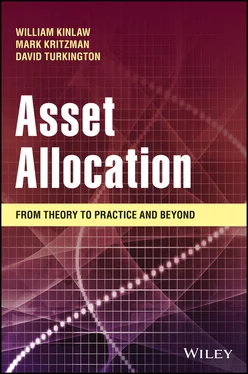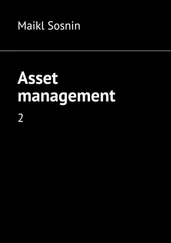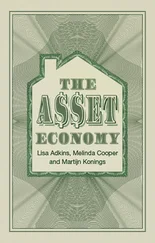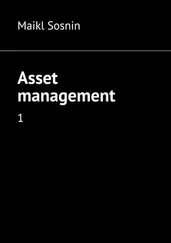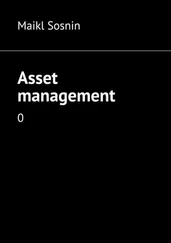1 ...8 9 10 12 13 14 ...18 From this formulation of portfolio risk, Markowitz was able to offer two key insights. First, unless the asset classes in a portfolio are perfectly inversely correlated (that is, have a correlation of –1), it is not possible to eliminate portfolio risk entirely through diversification. If a portfolio is divided equally among its component asset classes, for example, as the number of asset classes in the portfolio increases, the portfolio's variance will tend not toward zero but, rather, toward the average covariance of the component asset classes.
Second, unless all the asset classes in a portfolio are perfectly positively correlated with each other (a correlation of 1), a portfolio's standard deviation will always be less than the weighted average standard deviation of its component asset classes. Consider, for example, a portfolio consisting of two asset classes, both of which have expected returns of 10% and standard deviations of 20% and which are uncorrelated with each other. If we allocate the portfolio equally between these two asset classes, the portfolio's expected return will equal 10%, while its standard deviation will equal 14.1%. The portfolio offers a reduction in risk of nearly 30% relative to investment in either of the two asset classes separately. Moreover, this risk reduction is achieved without sacrificing any expected return.
Markowitz also demonstrated that, for given levels of risk, we can identify particular combinations of asset classes that maximize expected return. He deemed these portfolios “efficient” and referred to a continuum of such portfolios in dimensions of expected return and standard deviation as the efficient frontier . According to Markowitz's E-V maxim, investors should choose portfolios located along the efficient frontier. It is almost always the case that there exists some portfolio on the efficient frontier that offers a higher expected return and less risk than the least risky of its component asset classes (assuming the least risky asset class is not completely risk free). However, the portfolio with the highest expected return will always be allocated entirely to the asset class with the highest expected return (assuming no leverage).
Though all the portfolios along the efficient frontier are efficient, only one portfolio is most suitable for a particular investor. This portfolio is called the optimal portfolio. The theoretical approach for identifying the optimal portfolio is to specify how many units of expected return an investor is willing to give up to reduce the portfolio's risk by one unit. If, for example, the investor is willing to give up two units of expected return to lower portfolio variance (the squared value of the standard deviation) by one unit, his risk aversion would equal 2. The investor would then draw a line with a slope of 2 and find the point of tangency of this line with the efficient frontier (with risk defined as variance rather than standard deviation). The portfolio located at this point of tangency is theoretically optimal because its risk/return trade-off matches the investor's preference for balancing risk and return.
There are four steps to the practical implementation of portfolio theory. We must first identify eligible asset classes. Second, we need to estimate their expected returns, standard deviations, and correlations. Third, we must isolate the subset of efficient portfolios that offer the highest expected returns for different levels of risk. And fourth, we need to select the specific portfolio that balances our desire to increase wealth with our aversion to losses.
Before we describe these steps in detail, it may be useful to review two conditions upon which the application of portfolio theory depends.
For a given time horizon or assuming returns are expressed in continuous units, it is a remarkably robust portfolio formation process, assuming that at least one of two conditions prevails: either investor preferences toward return and risk can be well described by just mean and variance, or returns are approximately elliptically distributed.
The objective function for mean-variance analysis is a quadratic function, which many investors find problematic because it implies that at a particular level of wealth investors would prefer less wealth to more wealth. Of course, such a preference is not plausible, but as shown by Levy and Markowitz (1979), 2 mean and variance can be used to approximate a variety of plausible utility functions across a wide range of returns reasonably well. If this condition is satisfied, it does not matter how returns are distributed, because investors care only about mean and variance.
If this condition is not satisfied, however, mean-variance analysis requires returns to be approximately elliptically distributed. The normal distribution is a special case of an elliptical distribution, which is itself a special case of a symmetric distribution. A normal distribution has skewness equal to zero, and its tails conform to a kurtosis level of three. 3 An elliptical distribution, in two dimensions (two asset classes), describes a scatter plot of returns in which the return pairs are evenly distributed along the boundaries of ellipses that are centered on the mean observation of the scatter plot. 4 It therefore has skewness of zero just like a normal distribution, but it may have non-normal kurtosis. The same is true for symmetric distributions more generally, though they also allow for return pairs in a two-dimensional scatter plot to be unevenly distributed along the boundaries of ellipses that are centered on the mean observation of the scatter plot, as long as they are distributed symmetrically. A symmetric distribution that comprises subsamples with substantially different correlations would not be elliptical, for example. The practical meaning of these distinctions is that mean-variance analysis, irrespective of investor preferences, is well suited to return distributions that are not skewed, have correlations that are reasonably stable across subsamples, and have relatively uniform kurtosis across asset classes, but may include a higher number of extreme observations than a normal distribution.
In Chapter 1, we introduced seven characteristics that define an asset class: 5
1 The composition of an asset class should be stable.
2 The components of an asset class should be directly investable.
3 The components of an asset class should be similar to each other.
4 An asset class should be dissimilar from other asset classes in the portfolio as well as combinations of the other asset classes.
5 The addition of an asset class to a portfolio should raise its expected utility.
6 An asset class should not require selection skill to identify managers within the asset class.
7 An asset class should have capacity to absorb a meaningful fraction of a portfolio cost-effectively.
For illustrative purposes we begin by considering the following seven asset classes in our asset allocation analysis: domestic equities, foreign developed market equities, emerging market equities, Treasury bonds, US corporate bonds, commodities, and cash equivalents. 6
Estimating Expected Returns
Before we estimate expected returns, we must decide which definition of expected return we have in mind. If we base our estimate of expected return on historical results, we might assume that the geometric average best represents the expected return. After all, it measures the rate of growth that occurred historically or what should happen prospectively with even odds of a better or worse result. However, it does not measure what we should expect to happen on average over many repetitions; the arithmetic average gives this value. But there is a more practical reason for choosing the arithmetic average instead of the geometric average as our estimate of expected return. The average of the geometric returns of the asset classes within a portfolio does not equal the geometric return of the portfolio, but the average of the arithmetic returns does indeed equal the portfolio's arithmetic return. Because we wish to express the portfolio's return as the weighted average of the returns of the component asset classes, we are forced to define expected return as the arithmetic average. 7 Of course, we are not interested in the arithmetic average of past returns unless we believe that history will repeat itself precisely. We are interested in the arithmetic average of prospective returns.
Читать дальше
